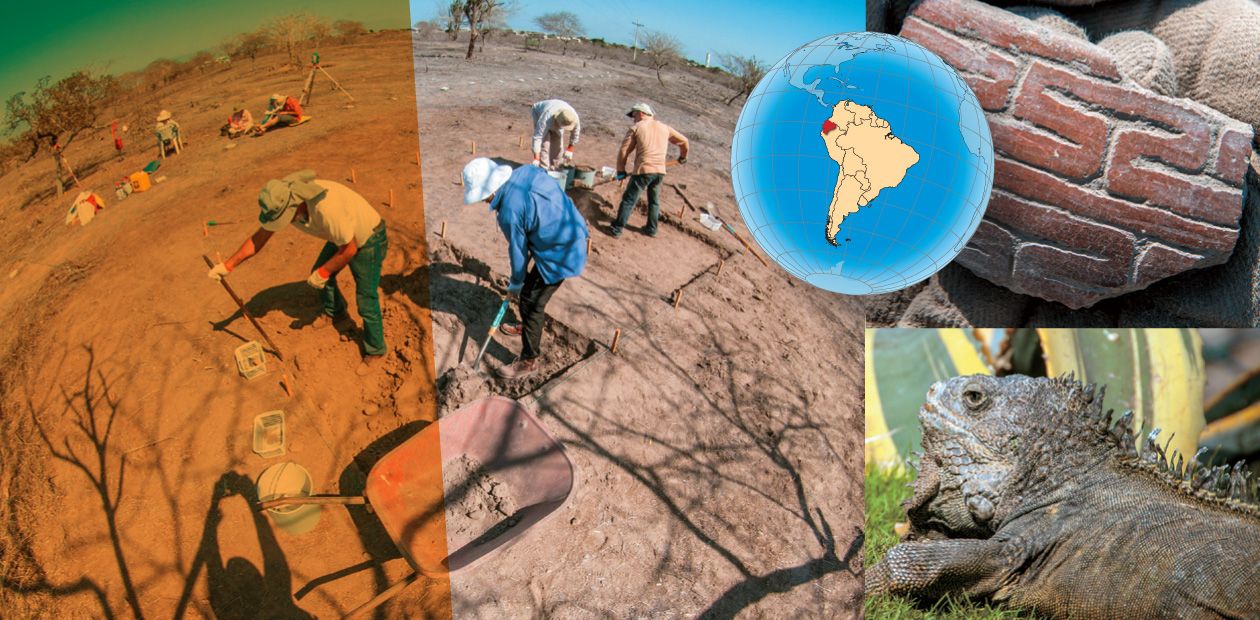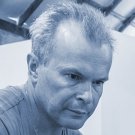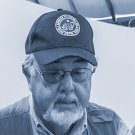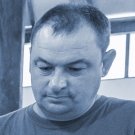Storming the Royal Hills: Russian Archaeological Expedition in Ecuador
The authors of this article were brought together by one of the most interesting and unsolved problems of the archaeology of pre-Columbian America, i.e., the age and the place of origin of pottery on the South American continent. According to the most daring hypothesis, pottery first appeared on the coast of Ecuador in the early agricultural Valdivia culture 5000 years ago, due to the transoceanic sailing of the representatives of the Jomon culture from the Japanese archipelago. Most archaeologists, however, believe that one should look for the origins of the Valdivia pottery on the American continent
The search for the early cultures on the coast of Ecuador is commonly associated with the name of Emilio Estrada Icaza, an amateur archaeologist and businessman, and with those of B. J. Meggers and C. Evans, a married couple from the United States, who were archaeologists from the Smithsonian Institution. A landmark event occurred in 1956 when an archaeological expedition found a layered archaeological site with previously unknown ceramics in the small fishing village of Valdivia. The age of the Valdivia culture, determined using radiocarbon dating, was 4,500—4,000 years, which gave reason to believe that this was the oldest pottery not only in Ecuador but in all of South America. Based on the characteristic features of the Valdivia ceramics, Estrada proposed a totally unexpected version, which provoked a heated debate: the newly found Ecuadorian culture takes its origin on the Japanese archipelago, i. e., in the Jomon culture!*
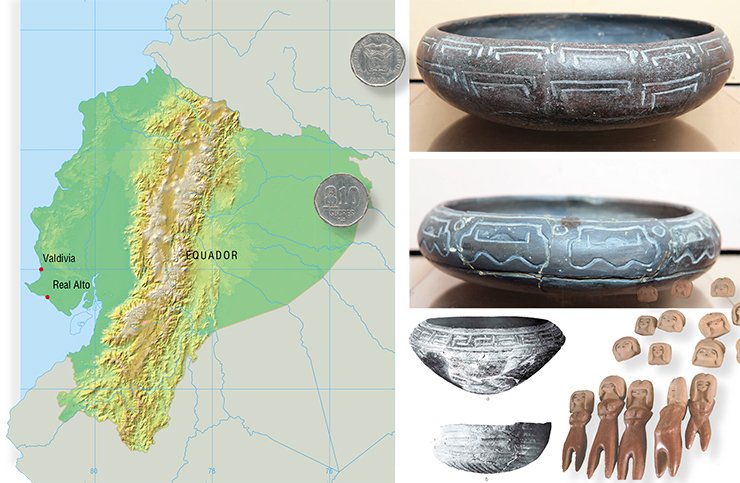
The intrigue around the origins of ceramic pottery in South America was exacerbated by the new archaeological discoveries made in the coastal areas of Ecuador in the 1970s and 1980s. One of them was the Valdivia Real Alto site, which was discovered in the southern part of the Santa Elena Peninsula in 1971. In the mid-1970s and early 1980s, a US–Ecuadorian expedition made three trenches to find traces of numerous dwellings, earth platforms, ceremonial sites, and burials with a rich inventory. Those findings helped establish the chronology of the Valdivia culture (5,500—3,500 years ago) and propose a detailed classification of the discovered ceramic pottery. In 1988, a museum complex was officially set up at Real Alto under the auspices of Escuela Politecnica del Litoral (ESPOL, Guayaquil), the largest such institution in Ecuador.
Despite all these achievements, the overall situation with the study of the Valdivia culture remains rather paradoxical. Over all these years, researchers still have not answered a number of questions including some key issues. Firstly, what was the origin of this early farming culture? After all, there is a mysterious gap of almost a thousand years between this culture and its predecessor preceramic culture of Las Vegas (a culture of hunter-gatherers, dating back to the age 10,000—6,600 years ago). Secondly, how did the Valdivia culture acquire the ceramic pottery technology—was it invented locally on the coast of Ecuador, or was it “imported”? Finally, was Estrada right when putting forward the hypothesis that the Valdivia pottery had come across the ocean?
There are no answers to these key questions because only five of the thirty currently known Valdivia sites have been excavated (and the works were conducted on a very limited scale). Even at Real Alto, which is now a museum, excavations have covered no more than 5% of the site’s area. Thus, the new excavations at this unique national cultural heritage site were expected to give an opportunity to find answers to the long-standing questions for Ecuadorian scientists; for their colleagues from Russia, it was the first in the history of Russian science archaeological expedition to South America.
The Russian team included professionals and postgraduate and master degree students from Vladivostok, Novosibirsk, and Moscow; in Guayaquil the expedition was joined by ESPOL undergraduates and Professor Y. Kanomata of Tohoku University (Sendai, Japan). Previously, three master degree students (Neotropical Archaeology) from Ecuador took part in excavations of a Neolithic monument on the Russky island in Vladivostok, which were organized by one of the authors of this article, Alexander Popov. The experience of these works proved exceptionally useful during the excavations in Ecuador.
Finally, in September 2014 an international team of scientists went to “storm” Real Alto, or Royal Hills, named after the ship carrying royal golden Real coins, which suffered a shipwreck near the coast. Archaeologists, hoped, however, to find a treasure of their own, i. e., priceless “clay shards” and other unique artifacts.
Archaeology in the Tropics
It takes a little more than two hours to drive from Guayaquil to Real Alto. Our camp is based straight in the museum complex, which consists of a building that houses a large museum exhibition, a laboratory with three residential rooms and bathrooms, a hall for meetings and lectures, a small kitchen, and a bamboo house on stilts, a traditional building for this part of Ecuador. The latter serves both as a museum exhibit and as a residence for the male part of the team. Apart from us, the museum curator, a Manteño Indian who goes by a surprising name Byron, lives in the complex with his family, and he was very enthusiastic about settling our domestic affairs.
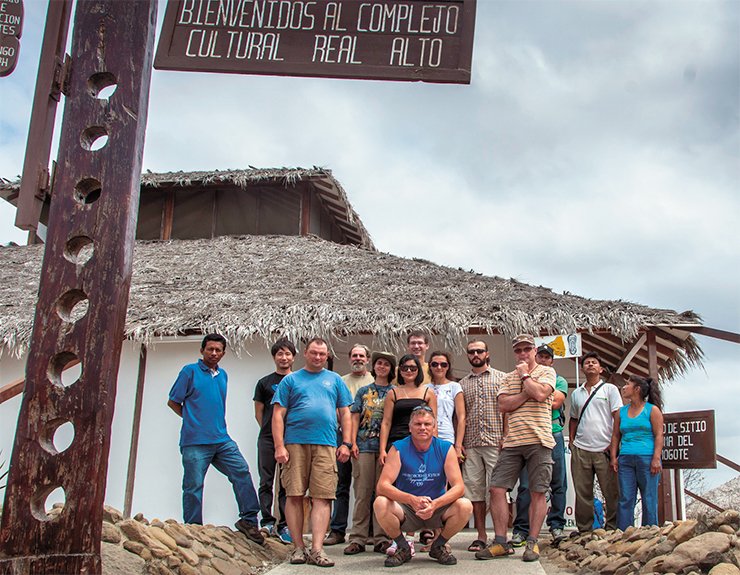
We must pay tribute to our South American partners from ESPOL: they did their best to make our work and stay at Real Alto most comfortable. We always had a microvan at our disposal, several modems to access the Internet, cell phones and even radios for communication between the camp and the excavation site. A small roadside cafe nearby provided three meals a day, and the museum complex promptly overhauled its entire sewer system. We were in constant contact with the university, and anything that could not be purchased on the spot was quickly delivered from Guayaquil.
The Russian team, in turn, had to cross half of the world with a sizable load of equipment in their luggage, from a total station theodolite (TST) to ground-penetrating radar (GPR), and had to have long talks at customs offices at each interim point of the flight.
...The treacherous Ecuadorian tropics dictate their own working-day schedule. In the days of the Valdivia culture, the settlement was surrounded by wet mangroves, whereas the modern landscape is more of a semi-desert with dry thorns, cacti, and scarce trees. We got up not later than at 6 a.m., had breakfast, and arrived at the excavation site before 8 a.m. The heat, not sparing us despite a special tent, forced to take a three-hour lunch break in the afternoon. After lunch, a light refreshing breeze began to blow from the ocean, but it grew dark rapidly at 6 p.m., and we had to move to a cameral laboratory at the camp.
Finally, at the end of most days, we were composing a Russian-English-Spanish dictionary. It was not so much about finding equivalents for archaeological terms and names of the different findings. Much more important was to make a glossary of action at the digging site, i.e., how to hold a shovel, how to clean the walls of the excavation unit, how to explain the rules of sweeping and extracting from the layer, etc. No one has composed such a glossary ever before.
Treasures of Real Alto
Excavations in South America are like excavations on another planet, so unfamiliar and strange everything is. On the other hand, we made serious preparations for this project: collected and studied almost all the scientific literature on the Valdivia culture, were in active correspondence with archaeologists who had worked in Ecuador, had made three visits to the site in previous years, and had even chosen the place for the excavation unit in advance.
For this, we chose an untouched spot in the northeast (the most elevated) part of the site. Not far from it, there was a trench excavated by the team led by the American archaeologist J. Dump in 1984, where it was possible to follow the traces of the early phases of the Valdivia culture and establish, based on radiocarbon dating, two of the earliest Real Alto dates: 5495 and 5620 years ago.
The total area of our excavation unit in 2014 was 16 m2 (two sectors of 8 m2 each). The excavations were performed consistently, by delicate removals of small (8—10 cm) horizons, which were followed by sweeping and careful selection through the soil for stone, ceramics, and shells. The whole process was documented with cameras.
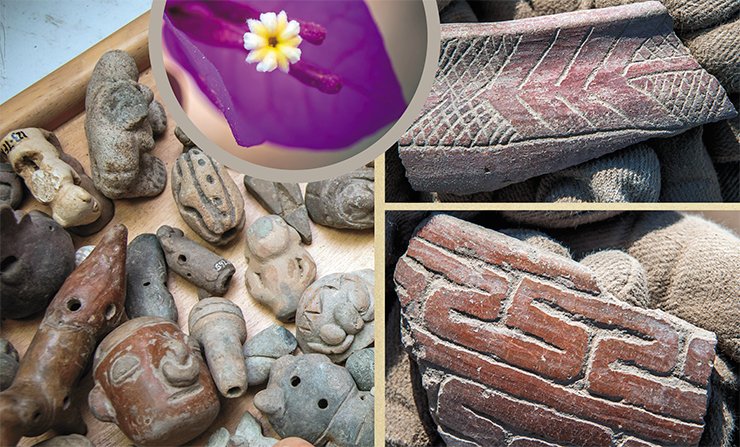
Since the horizons of occupation at the site are composed of thick alluvial and aeolian deposits, they instantly turn into very fine dust upon drying. To track the nature of the occurrence of artifacts, the excavation wall had to be constantly moistened with water from a special hand pump. We could work only with gloves on, as small shells cut our fingers like a razor.
...Gradually, the excavation picture became clearer. The archaeological material was arbitrarily divided into three successive layers, with the “richest” (containing stone, ceramics, shells, separate bones of some birds and mammals) material in two upper layers. Members of the expedition could not help but marvel at the variety of shapes and ornamental compositions of the Valdivia ware: triangles and trapezoids, little relief rolls, prints of corn seeds... Numerous shell valves (“food waste”) and products made of them: stamps for ceramics, knick-knackery, fragments of vessels or “ladles.” Specific attention was paid to several discoveries of elongated pebbles made of soft stone of yellow, white, and orange color. Most likely, they were made for the production of the famous female figures—Valdivian “Venuses.”
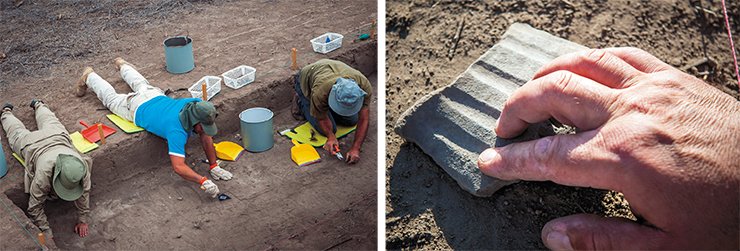
Under the lowest layer of ceramics, there was a dense (10—15 cm) layer with a multitude of shell valves. Further excavations in one of the squares showed that there was no archaeological material beneath a depth of 30—35 cm.
Besieged from all sides
Our expedition was conceived as a multidisciplinary project from the very beginning and involved the use of various field techniques. Thus, in parallel with the excavations, there were land surveys of the Real Alto area, soil sampling for pollen analysis and paleoclimate reconstructions, and GPR scanning of the monument area.
We put particular hope in the latter method: GPR provides a unique opportunity to see the nature and sequence of the settlement of a particular site, the location of housing structures, utility areas, and other facilities. The principle of GPR operation is based on emitting ultrawideband radiation pulses in VHF and UHF electromagnetic bands and receiving the signal reflected from buried items or anomalies (archaeological objects), which differ from the surrounding medium in their dielectric constants or in conductivity. At Real Alto, GPR studies were conducted over the area of 120 × 90 m, which was divided into 18 compass-oriented polygons.
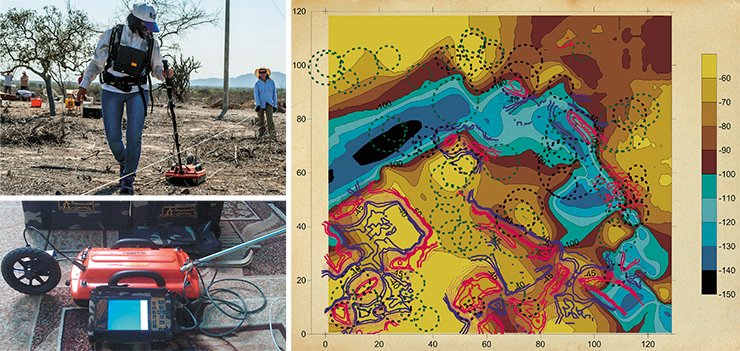
From the middle part of the artifact-bearing sediments, we extracted samples for radiocarbon dating: two samples from charred pottery shards, and one from a small piece of coal. As already mentioned, the archaeological materials were accompanied by a significant number of shells and bones of mammals (dog, roe deer), fish and birds; there even were some bones of large marine animals (possibly whales). All these findings were carefully processed and classified by a paleobiologist.
Especially noteworthy is the contribution of our Japanese colleague, Professor Y. Kanomata, who brought a small microscopic lab. This equipment was used for microscopic searches for traces of usage on stone artifacts. After all, the vast majority of stone objects are rough pebble flakes, and one needs a binocular research microscope to determine their functions.
Fruits of the Ecuadorian spring
The archaeological works at Real Alto ended at the peak of the Ecuadorian spring, when the semi-desert landscapes dappled with fresh colors, and a tree with a quirky Indian name guachepeli, right in front of the laboratory, blossomed with bright yellow flowers. The excavations at Real Alto were widely reported in the Ecuador media, and we even became famous for a while. Even the officers at the airport spared our luggage a thorough inspection.
Although little time has passed since finishing the works, we already have the first results, some of which are very interesting, if not sensational.
Firstly, at the end of October 2014, we established three new radiocarbon dates (from 4490 ± 30 to 4620 ± 30 years ago), which match the second phase in the history of the Valdivia culture and the typology of the archaeological material.
Secondly, all the discovered ceramic material fits very well in terms of its characteristics (shape of the vessels, their size, ornamentation) into the early stages of Valdivia: the additions of clay shards from later stages or from other cultures is less than 0.5%. Thus, it is obvious that the complex had not been disturbed and redeposited by subsequent settlers of the “Royal Hills.”
Judging by the discovered ceramics, the stone industry of the Valdivia culture differs only slightly from the preceding industry of the Las Vegas culture. The raw materials, the technique of percussion and the preparation of tools—all clearly indicate the local continuity. Moreover, the stratigraphic observation of the sequence of occupation layers did not confirm the existence of a significant gap between the pre-ceramic and early ceramic periods. Rather, it should be assumed that the transition from one period to the other occurred rapidly.
Finally, the preliminary decryption of the GPR sounding looks very intriguing. We expected that our device would only be able to “see” traces of dwellings and of shell mounds, but experts became assured in the existence of large artificial mounds from 20 cm to 1 m in height in this part of the monument. If this is so and the inhabitants of Real Alto began to build monumental structures from the earliest stages of the Valdivia culture (and not from the third stage, as was previously thought), then the timing of the early agricultural civilization in the Northern Andes is pushed back by nearly a thousand years!
Surely, all the data obtained in the course of the archaeological expedition in 2014 are subject to further analysis and cross-examination. However, the discovered early Valdivian ceramics has nothing to do with the Jomon pottery culture and can in no way originate from it. So far there is no evidence to support the hypothesis that pottery had arrived in Ecuador from Japan. However, there is another striking fact: even the earliest pottery shows a fairly sophisticated technology of shaping and firing. Therefore, the question about the age and place of origin of the local pottery is still open.
It should be noted that our results in no way remove the very possibility of ancient trans-Pacific voyages from the research agenda. The art of the later cultures in the coastal parts of Ecuador and Colombia shows a lot of most exciting similarities with the art of Japan and China, which await their own study and explanation.
Speaking about Real Alto, in September 2015 we had the second season of excavations. In addition to our Ecuadorian partners, the expedition included Russian experts from Vladivostok, Novosibirsk, and Moscow. We continued the geophysical surveys (to verify the nature of the anomalies and their location), paleofauna analysis, and works with the collections of anthropological material, including DNA sampling.
The main goal of Season 2015 was to detect the earliest manifestations of pottery on the South American continent, and the Real Alto site was the most promising in this respect. It is very important to find and clearly indicate the time of occurrence of the first pottery, the “birthday” of the new culture on the ancient Royal Hills.
Season 2015 surpassed all expectations. We were able to clearly detect a horizon (the lowest one in the excavation unit) in which, given an abundance of stone and bone tools and a mass assemblage of shell valves, we found not a single piece of pottery. This is the aceramic horizon, i.e., the initial period of human presence on the Royal Hills. However, even more important are the few pottery fragments—unusual artifacts with a primitive ornament—that were discovered at the interface of the aceramic and early ceramic horizons. Those objects had been produced using a simpler technology than the bulk of the pottery at Real Alto. They may be attributed, with a high probability, to the very first attempts at pottery-making; however, there is another, more exciting prospect: the site may contain non-Valdivia ceramics!
The researchers encountered many surprises—complexes with stone grinders, female figurines made of clay and soft stone, fishing hooks made of shells, and, unexpectedly, two burials representing different burial rituals: primary (burial of the body of the deceased) and secondary (burial of the skeleton bones without the flesh). The anthropological material opens up a new chapter in the study of the Valdivia culture, i.e., the ability to analyze their age, diet, diseases, pathologies, and, of course, genetic code. We selected a series of samples, which are now being processed by our Japanese colleagues, and we are looking forward to the results.
References
Tabarev A.V., Marcos J.G., and Popov A.N. Ecuador: following an unusual archaeological hypothesis // SCIENCE First Hand, 2014. N 3(39), pp. 62—67.
Tabarev A.V. Kul’turnyi i paleoekonomicheskii aspekty poyavleniya drevneishei keramicheskoi posudy na vostoke Evrazii i v Yuzhnoi Amerike (Kolumbiya, Ekvador) (Cultural and paleoeconomic aspects of the origin of the most ancient pottery in the east of Eurasia and in South America (Columbia and Ecuador)/ Proc. of the 4th (20th) All-Russian Archaeological Congress in Kazan. Kazan: Otechestvo, 2014. Vol. 1, pp. 354—356 [in Russian].
Tabarev A.V. and Popov A.N. Vozvrashchenie v Yuzhnuyu Ameriku: nekotorye itogi, problemy, perspektivy (Back in South America: outcomes, challenges, and prospects) // Problems of Archaeology, Ethnography, and Anthropology of Siberia and Adjacent Territories. Novosibirsk: Inst. Arkheol. Etnogr. Sib. Otd. Ross. Akad. Nauk, 2014. Vol. 20, pp. 289—291 [in Russian].
*For more detail see SCIENCE First Hand, 2014. N 3 (39), pp. 62–79


